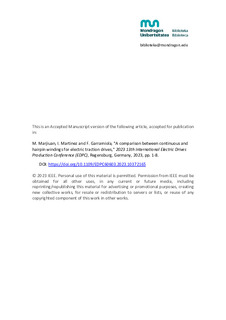| dc.contributor.author | Garramiola, Fernando | |
| dc.contributor.other | Marjiuan, Marta | |
| dc.contributor.other | Martinez, Iago | |
| dc.date.accessioned | 2024-04-10T09:43:54Z | |
| dc.date.available | 2024-04-10T09:43:54Z | |
| dc.date.issued | 2023 | |
| dc.identifier.isbn | 979-8-3503-7049-2 | en |
| dc.identifier.issn | 2832-6385 | en |
| dc.identifier.other | https://katalogoa.mondragon.edu/janium-bin/janium_login_opac.pl?find&ficha_no=174461 | en |
| dc.identifier.uri | https://hdl.handle.net/20.500.11984/6340 | |
| dc.description.abstract | Present change in mobility to vehicle electrification involves highly exigent requirements on product performance and production technologies. In the manufacturing of electric machines, the stator winding is the most challenging and cost demanding process. Within this context, the existing winding technologies need to be optimised to improve their product and process robustness. Axially inserted hairpins are widely used since they present an attractive design for high power and high torque density traction applications. However, the welding of the hairpins is a complex step that leads to high costs of rejects and frequent appearance of faults. Consequently, the radially inserted continuous winding provides a whole new potential for electric powertrains where the manufacturing process can be significantly simplified. This paper introduces a comparison of two flat wire assembly technologies for mass-produced stators: continuous and hairpin windings. Production stages of each winding technology are reviewed. Moreover, main design constraints and challenges of continuous winding motors are exposed. A Finite Element Method (FEM) based performance comparison of two Interior Permanent Magnet Synchronous Machines (IPMSM) with hairpin and continuous winding is presented. The torque, power, torque ripple, losses, Worldwide Harmonised Light Vehicles Test Procedure (WLTP) efficiency and demagnetisation characteristics are analysed. Finally, new design considerations to overcome the limitations and the performance reduction of continuous winding motors are proposed. | en |
| dc.language.iso | eng | en |
| dc.publisher | IEEE | en |
| dc.rights | © 2023 IEEE | en |
| dc.subject | Windings | en |
| dc.subject | electric vehicle | en |
| dc.subject | interior permanent magnet synchronous motor | en |
| dc.subject | design for manufacturing | en |
| dc.subject | ODS 7 Energía asequible y no contaminante | es |
| dc.subject | ODS 9 Industria, innovación e infraestructura | es |
| dc.title | A comparison between continuous and hairpin windings for electric traction drives | en |
| dc.type | http://purl.org/coar/resource_type/c_c94f | |
| dcterms.accessRights | http://purl.org/coar/access_right/c_abf2 | en |
| dcterms.source | 13th International Electric Drives Production Conference (EDPC). Pp. 1-8. Regensburg (Germany), 29-30 November, 2023 | en |
| local.contributor.group | Accionamientos aplicados a la tracción y a la generación de energía eléctrica | es |
| local.description.peerreviewed | true | en |
| local.identifier.doi | https://doi.org/10.1109/EDPC60603.2023.10372165 | en |
| local.contributor.otherinstitution | GKN Automotive | es |
| oaire.format.mimetype | application/pdf | en |
| oaire.file | $DSPACE\assetstore | en |
| oaire.resourceType | http://purl.org/coar/resource_type/c_c94f | en |
| oaire.version | http://purl.org/coar/version/c_ab4af688f83e57aa | en |
| oaire.funderName | Comisión Europea | en |
| oaire.funderIdentifier | https://ror.org/00k4n6c32 / http://data.crossref.org/fundingdata/funder/10.13039/501100000780 | en |
| oaire.fundingStream | HORIZON 2.5 | en |
| oaire.awardNumber | 101096306 | en |
| oaire.awardTitle | Novel concept of a Low Cost, High Power Density and Highly Efficient Recyclable motor for next generation mass produced electric vehicles (HEFT) | en |
| oaire.awardURI | https://doi.org/10.3030/101096306 | en |







